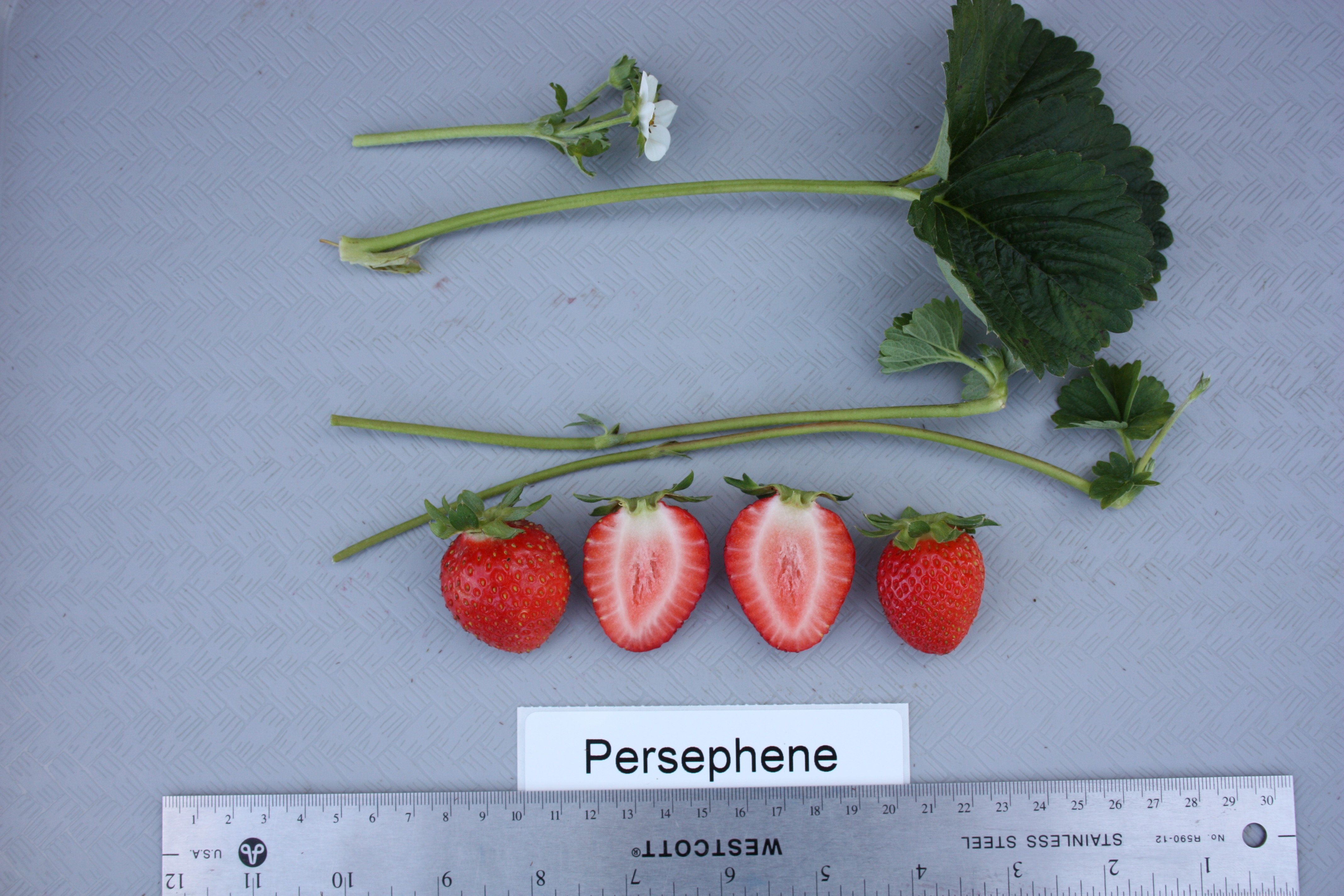Persephene
| Denomination: | 'Persephene' |
|---|---|
| Botanical Name: | Fragaria × ananassa |
| Applicant/Holder: |
Sweet Darling Sales, Inc. 24 Seascape Village Aptos, California 95003 United States of America |
| Breeder: |
John Larse, Sweet Darling Sales, Inc., Aptos, United States of America |
| Agent in Canada: |
Deeth Williams Wall LLP Suite 400, 150 York Street Toronto, Ontario M5H 3S5 Canada Tel: (416) 941-9440 |
| Application Date: | 2019-04-23 |
| Provisional Protection:: | 2019-04-23 |
| Application Number: | 19-9777 |
| Grant of Rights Date: | 2020-09-21 |
| Certificate Number: | 6271 |
| Grant of Rights Termination Date: | 2040-09-21 |
Variety Description
Variety used for comparison: 'Seascape'
Summary: The foliage of 'Persephene' is dense whereas the foliage of 'Seascape' is of medium density. The plants of 'Persephene' have strong vigour whereas those of 'Seascape' have medium vigour. The leaf of 'Persephene' has strong blistering whereas the blistering is absent or weak on the leaf of 'Seascape'. The base of the terminal leaflet is rounded for 'Persephene' whereas it is acute for 'Seascape'. 'Persephene' has a long petiole whereas the petiole of 'Seascape' is short. The plants of 'Persephene' begin to flower late in the season whereas the plants of 'Seascape' begin to flower early in the season. For the flower of 'Persephene', the calyx is larger than the corolla whereas the calyx is smaller than the corolla of 'Seascape'. There is no difference or a very slight difference in the shape of the terminal fruit and other fruit of 'Persephene' whereas it is moderately different for 'Seascape'. The fruit of 'Persephene' is ovoid, large and very firm whereas that of 'Seascape' is rhomboid, medium sized and of medium firmness. The diameter of the calyx is much larger than the fruit of 'Persephene' whereas it is slightly smaller than the fruit of 'Seascape'. Excluding the core, the fruit flesh of 'Persephene' is whitish whereas that of 'Seascape' is medium red.
Description:
PLANT: fully remontant bearing type, upright growth habit, dense foliage, strong vigour
STOLONS: medium number, absent or very weak intensity of anthocyanin colouration, medium density pubescence
LEAF: small to medium sized, blue green on upper side, strong blistering, strong glossiness, no variegation
TERMINAL LEAFLET: much longer than wide, rounded base, crenate margin, straight in cross-section
PETIOLE: long, slightly outwards attitude of hairs
STIPULE: absent or very weak intensity of anthocyanin colouration
FLOWERING: begins late season
INFLORESCENCE: positioned below foliage, many flowers
PEDICEL: horizontal attitude of hairs
FLOWER: calyx larger than corolla, touching petal arrangement, stamens present
PETAL: length equal to width, white inner side
CALYX: raised attachment, outwards attitude of sepals, diameter much larger than fruit, strong adherence to fruit
FRUIT: begins ripening mid-season, moderately longer than wide, large, ovoid, none to very slight difference in shape between terminal fruit and other fruit, narrow band without achenes
FRUIT SURFACE: orange red, strong glossiness, even or very slightly uneven colour, even or very slightly uneven surface, achenes positioned level with fruit surface
FRUIT FLESH: very firm, whitish, white core, absent or small cavity
Origin & Breeding History: 'Persephene' originated from a cross made on June 2, 2015 at Sweet Darling Sales, Inc. in Watsonville, California, USA. The cross was conducted between the proprietary, unreleased varieties '108080' (female parent) and '107801' (male parent). 'Persephene' was selected on June 7, 2016 based on the quality and quantity of inflorescence and fruit. Since its selection, asexually reproduced stolons have been tested in California at low and high elevations.
Tests & Trials: The comparative trial for 'Persephene' was conducted during the summer of 2019 in Lavaltrie, Quebec. A minimum of 20 bareroot plants per variety were planted in double row raised beds in late April 2019. The raised beds were approximately 25 cm high by 32 cm wide, spaced 1.5 metres apart and covered with white plastic. The plants were spaced 30 cm apart in a staggered pattern. There were 2 replicates. Measured characteristics were taken from 15 plants, or parts of plants.
Click on image for larger view

Strawberry: 'Persephene'
Click on image for larger view

Strawberry: Reference variety 'Seascape'
- Date modified: